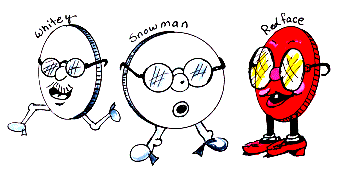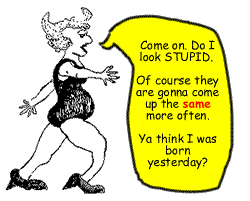|












Copyright ©
2003
themathlab.com
|
|

| 380
Simple Experimental Probability |

| How
to use experiments to figure out the chances that something
will happen |

- one
red and two white poker chips
 ,
or 3 pennies and a permanent marker ,
or 3 pennies and a permanent marker
- a non
see-thru container like a cup to put the chips in
- a nickel
a penny and some tape
- calculator
- two dice or
our own ELECTRONIC
DIE
- paper and pencil
|

|
We
here at themathlab.com love to
perform this quick and dirty little experiment on any unsuspecting
students we find. It's called the "THREE
BLIND CHIPS EXPERIMENT."

Here's
how it goes:
- First place
one red and two white chips in a non see-thru container
while your audience is watching. Be sure to make a lot of
fanfair as you do this, and stress there are TWO white and
only ONE red chip in the container.
- Next, tell the
audience that you will be shaking this container, closing
your eyes, and drawing out two chips at a time. You will
record whether they are the same color or different colors
on a piece of paper, then you will replace the two chips
and draw again. You tell them you will do this 50 times.
- Now ask them
to guess which will be drawn more frequently two different
colored chips or two of the same color. What do YOU think
it will be?

GO
AHEAD AND TRY THIS EXPERIMENT before you read any
more, we'll wait.
(NOTE: If you don't
have poker chips, try 3 pennies. Place a mark on one of them
with a permanent marker. As long as they feel the same the
results will be valid.)
************
DID YOU REALLY DO IT?
OKAY, WE ARE ASSUMING
THAT YOU
REALLY,
REALLY,
REALLY,
DID
DO
THE EXPERIMENT!
SO NOW,
****
Go ahead and count
up all the times you drew the SAME color and how many times
you drew DIFFERENT colors.
Most
people are amazed at the results.
|

- Find
the experimental probability of flipping a coin and getting
a head. Do this experiment 50 times and give your results
as a fraction, decimal, and as a percent.
- Now
let's try to make an "UNFAIR" coin. Take your
nickel and your penny and tape them together so that the
tail on the nickel is showing and the head of the penny
is showing on the other side. This should create a hybrid
coin which is heavier on one side. This is known as an unfair
coin. Take a guess what % of your flips will come up heads,
then actually do the experiment 50 times and see how close
you were?
- Now
take your two dice, or use our ELECTRONIC
DIE,
and roll them together. Run an experiment that will yield
the probablility of rolling two numbers whose sum is nine.
|
|
|



|
![]()
![]()
